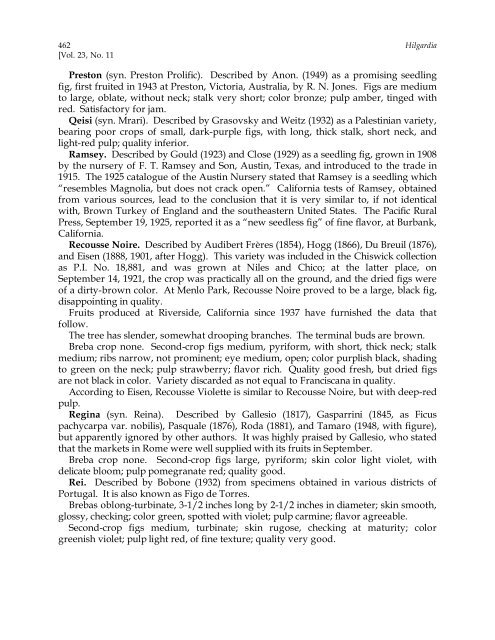Fig Varieties: A Monograph - uri=ucce.ucdavis
Fig Varieties: A Monograph - uri=ucce.ucdavis
Fig Varieties: A Monograph - uri=ucce.ucdavis
Create successful ePaper yourself
Turn your PDF publications into a flip-book with our unique Google optimized e-Paper software.
462 Hilgardia<br />
[Vol. 23, No. 11<br />
Preston (syn. Preston Prolific). Described by Anon. (1949) as a promising seedling<br />
fig, first fruited in 1943 at Preston, Victoria, Australia, by R. N. Jones. <strong>Fig</strong>s are medium<br />
to large, oblate, without neck; stalk very short; color bronze; pulp amber, tinged with<br />
red. Satisfactory for jam.<br />
Qeisi (syn. Mrari). Described by Grasovsky and Weitz (1932) as a Palestinian variety,<br />
bearing poor crops of small, dark-purple figs, with long, thick stalk, short neck, and<br />
light-red pulp; quality inferior.<br />
Ramsey. Described by Gould (1923) and Close (1929) as a seedling fig, grown in 1908<br />
by the nursery of F. T. Ramsey and Son, Austin, Texas, and introduced to the trade in<br />
1915. The 1925 catalogue of the Austin Nursery stated that Ramsey is a seedling which<br />
“resembles Magnolia, but does not crack open.” California tests of Ramsey, obtained<br />
from various sources, lead to the conclusion that it is very similar to, if not identical<br />
with, Brown Turkey of England and the southeastern United States. The Pacific Rural<br />
Press, September 19, 1925, reported it as a “new seedless fig” of fine flavor, at Burbank,<br />
California.<br />
Recousse Noire. Described by Audibert Frères (1854), Hogg (1866), Du Breuil (1876),<br />
and Eisen (1888, 1901, after Hogg). This variety was included in the Chiswick collection<br />
as P.I. No. 18,881, and was grown at Niles and Chico; at the latter place, on<br />
September 14, 1921, the crop was practically all on the ground, and the dried figs were<br />
of a dirty-brown color. At Menlo Park, Recousse Noire proved to be a large, black fig,<br />
disappointing in quality.<br />
Fruits produced at Riverside, California since 1937 have furnished the data that<br />
follow.<br />
The tree has slender, somewhat drooping branches. The terminal buds are brown.<br />
Breba crop none. Second-crop figs medium, pyriform, with short, thick neck; stalk<br />
medium; ribs narrow, not prominent; eye medium, open; color purplish black, shading<br />
to green on the neck; pulp strawberry; flavor rich. Quality good fresh, but dried figs<br />
are not black in color. Variety discarded as not equal to Franciscana in quality.<br />
According to Eisen, Recousse Violette is similar to Recousse Noire, but with deep-red<br />
pulp.<br />
Regina (syn. Reina). Described by Gallesio (1817), Gasparrini (1845, as Ficus<br />
pachycarpa var. nobilis), Pasquale (1876), Roda (1881), and Tamaro (1948, with figure),<br />
but apparently ignored by other authors. It was highly praised by Gallesio, who stated<br />
that the markets in Rome were well supplied with its fruits in September.<br />
Breba crop none. Second-crop figs large, pyriform; skin color light violet, with<br />
delicate bloom; pulp pomegranate red; quality good.<br />
Rei. Described by Bobone (1932) from specimens obtained in various districts of<br />
Portugal. It is also known as <strong>Fig</strong>o de Torres.<br />
Brebas oblong-turbinate, 3-1/2 inches long by 2-1/2 inches in diameter; skin smooth,<br />
glossy, checking; color green, spotted with violet; pulp carmine; flavor agreeable.<br />
Second-crop figs medium, turbinate; skin rugose, checking at maturity; color<br />
greenish violet; pulp light red, of fine texture; quality very good.
















![Fig Trees in North Carolina [Archive] - IDigMyGarden ... - Figs 4 Fun](https://img.yumpu.com/26905320/1/190x245/fig-trees-in-north-carolina-archive-idigmygarden-figs-4-fun.jpg?quality=85)